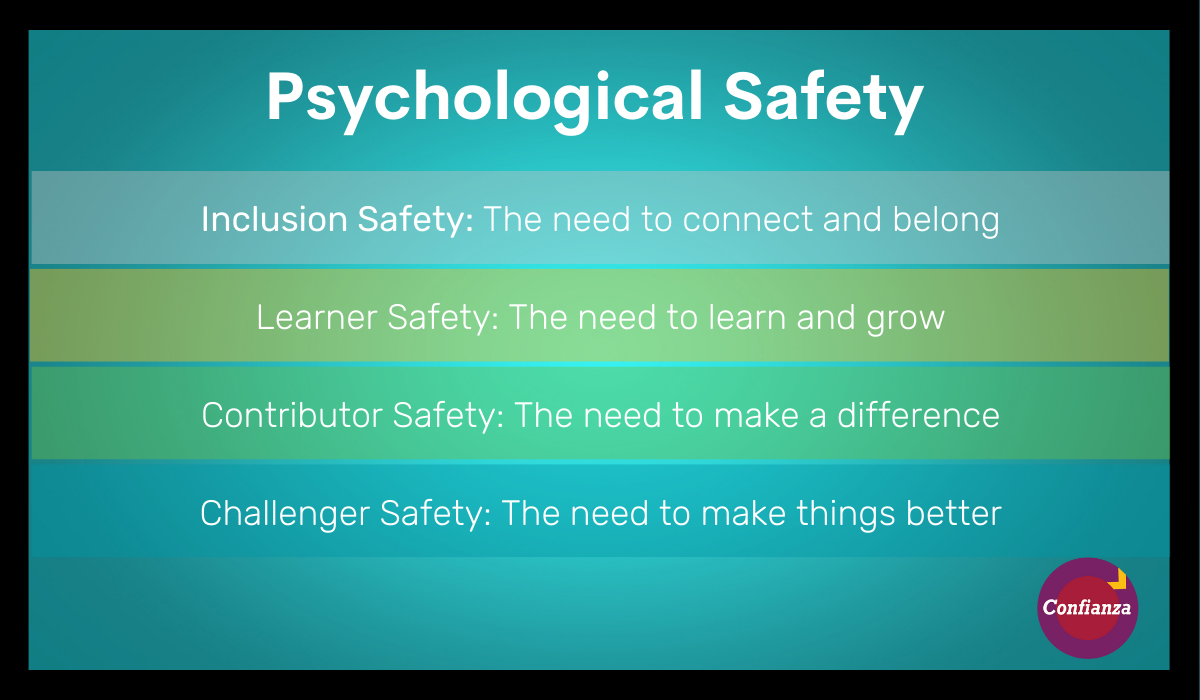How to Foster Psychological Safety at Work
by Maria Lee
Psychological Safety at Work Definition
The article ‘What is Psychological Safety at Work?’ notes that in a 2017 Gallup Poll, 3 out of 10 employees agree their opinions don't count at work. Leading effective staff who wrote the article believe remote work settings have worsened the problem since the COVID-19 pandemic, particularly for women. The article found in recent surveys from Catalyst found half of female business leaders face difficulties speaking up in remote meetings.
Leading effective staff at the Center for Creative Leadership defines psychological safety as the belief that you won't be punished or humiliated for speaking up with ideas, questions, concerns, or mistakes.
Why Is It Important
Business repercussions when there is lack of psychological safety at work:
When employees don't feel comfortable talking about initiatives that aren't working, the organization has lost the opportunity to leverage the strengths of all its talents.
Psychological safety at work does not mean you have to be nice all the time. It just means you embrace conflict and speak up, knowing your team has your back, and you have their back.
The 4 Stages of Psychological Safety
Psychological safety begins with a feeling of belonging. It has 4 stages (Leading Effective Staff 2022 pg 3-4):
Stage 1: Inclusion Safety - It satisfies the basic human needs to connect and belong. You feel safe to be yourself and are accepted for who you are, including your unique attributes and defining characteristics.
Stage 2: Learner Safety - It satisfies the need to learn and grow. You feel safe to exchange in the learning process, by asking questions, giving and receiving feedback, experimenting, and making mistakes.
Step 3: Contributor Safety - It satisfies the need to make a difference. You feel safe to use your skills and abilities to make a meaningful contribution.
Step 4: Challenger Safety - It satisfies the need to make things better. You feel safe to speak up and challenge the status quo when you think there are opportunities to change or improve.
Leading Effective Staff suggests leaders should promote and nurture their teams’ sense of psychological safety at work by helping employees move through the 4 Stages of Psychological Safety, and ultimately land where employees feel comfortable to take risks.
How to Create More Psychological Safety at Work
Leading Effective Staff believes leaders can provide and nurture their team's sense of psychological safety by helping employees move through the 4 stages and ultimately land in a place where they feel comfortable with interpersonal risk-taking. The staff provide the following 5 Tips for Leaders to help create a psychological safe workplace (Leading Effective Staff 2022 pg. 5):
Make Psychological Safety an Explicit Priority - Talk about the importance of creating psychological safety at work, connecting it to a higher purpose of promoting greater organizational innovation, team engagement, and inclusion. Model the behaviors you want to see, and set the stage by showing empathy in the workplace.
Facilitate Everyone Speaking Up - Show genuine curiosity and honor candor and truth-telling. Be open-minded, compassionate, and empathetic when someone is brave enough to say something challenging the status quo. Organizations with a coaching culture will likely have team members with the courage to speak the truth.
Establish Norms for How Failure is Handled - Don't punish experimentation and (reasonable) risk-taking. Encourage learning from failure and disappointment, and openly share your hard-won lessons learned from mistakes. Doing so will help encourage innovation, not sabotaging it.
Create space for new ideas (even wild ones) - When challenging an idea, provide the challenge in the larger context of support. Consider whether you only want ideas thoroughly tested, or whether you’re willing to accept highly creative, out-of-the-box ideas that are not yet well-formulated.
Embrace productive conflict - Leaders can set the stage for incremental change by establishing team expectations for factors that contribute to psychological safety. With your team, discuss the following questions:
How will team members communicate their concerns about a process that isn’t working?
How can reservations be shared respectfully with colleagues?
What are our norms for managing conflicting perspectives?
It is also a good idea for team members to help create more psychological safety at work by taking the following steps to promote productive dialog and debate suggested by Leading Effective Staff:
Ask colleagues powerful, open-ended questions, and then listen actively and intently to understand feelings and values, as well as facts.
Agree to share failures, recognizing that mistakes are an opportunity to learn and grow.
Use candor, whether expressing appreciation or disappointment.
Ask for help, and freely give help when asked.
Embrace expertise among many, versus a single “hero” mentality.
Encourage and express gratitude, which reinforces your team members’ sense of self.
Leading Effective Staff emphasizes that "most importantly, positive interactions and conversations between individuals are built on trust. Give your team members the benefit of the doubt when they take a risk, ask for help, or admit a mistake. In turn, trust that they will do the same for you." (Leading Effective Staff 2022 pg6)
Conclusion
The goal is, as suggested by Leading Effective Staff, "to create a psychologically safe work climate where team members aren’t worried about feeling rejected for speaking up. When that’s the case, not only does interpersonal risk-taking become the norm, but team members are also more adaptable in the face of change.” (Leading Effective Staff 2022 pg 9)
References
Leading Effectively Staff (2022, January 15). What Is Psychological Safety at Work? Center For Creative Leadership
Leading Effectively Staff (2021, December 2). Use Active Listening Skills to Coach Others Center For Creative Leadership
Leading Effectively Staff (2021, November 12). Gratitude at Work: How Giving Thanks Will Make You a Better Leader Center For Creative Leadership

